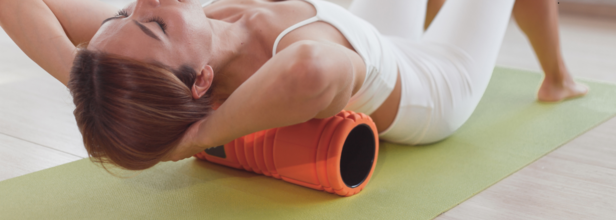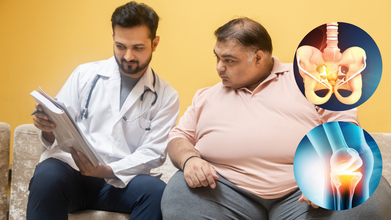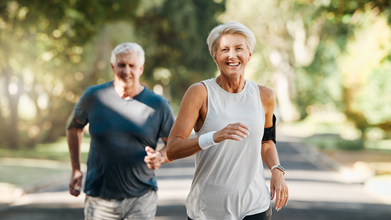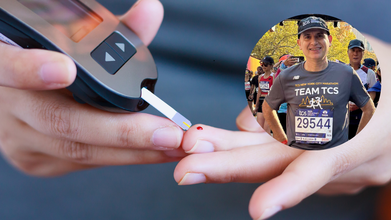- Health Conditions A-Z
- Health & Wellness
- Nutrition
- Fitness
- Health News
- Ayurveda
- Videos
- Medicine A-Z
- Parenting
What Are Foam Rollers And Where Do They Fit In Your Fitness Regime?

Credits: Canva
Fitness also means ensuring that as and while you workout, you also take enough rest and know how to col down. This means you must release the tension from your muscles to reduce soreness or tightness so your next workout session could be fruitful and without a pain. This where foam rollers can help you. They are cylindrical tools, that you must have seen in gym corners, used for self-myofascial release (SMR). This is a form of self massage.
So, what is the science behind foam roller?
Foam rolling focuses on myofascial release, targeting the fascia—a network of connective tissue covering your muscles. When fascia becomes tight due to physical trauma, inflammation, or scarring, it can restrict movement and cause discomfort. Foam rollers apply pressure to these tight areas, helping to:
- Reduce adhesions and knots
- Improve blood flow
- Break down scar tissue
- Enhance and range of motion
Is it really that effective? The effectiveness of foam rollers has been debated, but research offers some insights. Studies have shown that foam rolling:
Increases flexibility: Short-term gains in flexibility are noticeable, especially when foam rolling is part of a warm-up. Long-term improvements are also possible with consistent use.
Reduces muscle soreness: Rolling after workouts can ease delayed-onset muscle soreness (DOMS).
Enhances recovery: Post-exercise foam rolling accelerates muscle recovery compared to passive methods.
A study published in the Journal of Athletic Training highlighted that foam rolling post-workout improves muscle strength and proprioception (awareness of body position), making it a valuable recovery tool.
ALSO READ: Kickstart 2025: 10 Fitness Resolutions You Can Actually Keep
Benefits of Foam Rolling
- Increased Blood Flow: Promotes circulation, delivering oxygen and nutrients to muscles.
- Improved Flexibility: Prepares muscles for movement and enhances overall range of motion.
- Faster Recovery: Eases soreness and helps muscles recover faster after intense exercise.
- Mobility Enhancement: Improves joint function and movement.
How to Use a Foam Roller
Proper technique is key to reaping the benefits of foam rolling. Here’s a step-by-step guide:
- Target Tight Areas: Slowly roll over muscles, pausing on "hot spots" (tight or tender areas). Use gentle pressure.
- Breathe and Relax: Avoid tensing up. Let the roller do the work while you focus on relaxing.
- Small Movements: Focus on small, incremental movements instead of rolling the entire muscle length repetitively.
- Avoid Joints: Stick to soft tissues and avoid rolling directly over joints.
- Listen to Your Body: Foam rolling should not cause sharp pain. Adjust pressure as needed.
Choosing the Right Foam Roller
- Soft Foam Rollers: Ideal for beginners but less durable.
- Firm Foam Rollers: Provide deeper pressure for advanced users.
- Textured Rollers: Mimic hands-on massage techniques.
- Vibrating Rollers: Offer added intensity and can help with deep tissue release.
Prices range from as low as $5 to over $200, depending on features and build quality.
Where Foam Rollers Fit in Your Fitness Regime
Before Exercise: Improve blood flow and flexibility during warm-ups.
After Exercise: Speed up recovery and reduce soreness.
Daily Maintenance: Keep muscles and fascia in optimal condition, even on rest days.
Obesity Is Driving A Rise In Knee And Hip Surgeries, According To Doctor

Credits: iStock
Obesity is not just about how waist size or BMI, but it’s now reshaping the kinds of injuries patients are coming to orthopedic clinics. According to Dr. Rakesh Mattoo, Director of Orthopedics & Joint Replacement at Max Smart Super Speciality Hospital, Saket, the link between weight gain and joint degeneration is now impossible to ignore. “In India, cases of obesity-related osteoarthritis have increased by 30–35 percent over the last ten years, especially in urban areas,” he explains.
Orthopedic surgeons are seeing the consequences every day. “Approximately 55–60% of our knee replacement patients are now overweight or obese, up from about 35–40% a decade ago,” Dr. Mattoo shares. A similar pattern exists with hip replacements: obesity now accounts for nearly 28–30% of those cases, compared with 15% in 2010. The physics behind this trend are sobering, studies show that “every 5 kg of extra weight increases the load on the knees by approximately 15–20 kg,” accelerating cartilage wear and hastening surgical intervention.
What Is Happening In India?
These clinical numbers reflect a far larger population trend. India’s burden of obesity has been rising steadily for decades. In 2022, around 70 million adults in India were classified as obese, including 44 million women and 26 million men, according to data published in The Lancet. This marks a sharp rise from the early 1990s, when obesity rates were much lower. Overall, obesity prevalence climbed from 1.2% to 9.8% in women and 0.5% to 5.4% in men between 1990 and 2022. Additionally, overweight and obesity together affect nearly one in four Indian adults, nearly 24% of women and 23% of men aged 15–49, and even children are showing increases in overweight prevalence.
It’s not just body weight that matters, but where fat is stored. Central abdominal fat, that stubborn belly, is one of the greatest predictors of early joint degeneration, says Dr. Mattoo. And certain groups are at especially high risk: women (particularly post-menopausal), people with prior knee injuries, those with family histories of osteoarthritis, and individuals leading sedentary lives. Conditions like diabetes, hypothyroidism, and metabolic syndrome also create a kind of chronic internal inflammation that accelerates cartilage breakdown.
How Can You Stay Safe?
So what can someone do to protect their joints before they reach the operating table? Dr. Mattoo emphasizes realistic, sustainable steps:
Keep weight in check: Even losing 5–10% of body weight can significantly ease stress on knees and slow osteoarthritis progression.
Build strength: Strengthening the muscles around the thigh, hip, and knee, along with the core, helps distribute load and protect joints. Moderate, low-impact activities like walking, cycling, or swimming are far kinder to joints than high-impact exercise.
Eat smart: “Choose joint-friendly nutrition,” he urges, including foods rich in omega-3s, calcium, vitamin D, and protein, all essential for healthy muscle and cartilage.
Don’t rush into high-impact activity: Running, jumping, or poorly executed gym movements may feel energizing but can do more harm than good if your body isn’t prepared.
Get routine screening: Annual check-ups — including BMI, vitamin D levels, blood glucose, and lipid profiles — catch early risk factors so that preventive measures can be taken.
Looking at younger adults, building strong musculature between ages 20–35 isn’t vanity — it’s protection. Dr. Mattoo points out that muscle mass helps slow degenerative joint changes over decades. Simple habits like walking 6,000–10,000 steps a day, practicing correct posture, and avoiding harmful sitting patterns or lifting techniques go a long way.
With air pollution keeping many indoors, lifestyle changes have to adapt. Structured home workouts like resistance bands, yoga, or bodyweight exercises can mimic outdoor benefits. Even small changes — standing desks, walk-and-talk phone calls, frequent stretch breaks — increase daily calorie burn and reduce sedentary strain.
The rising tide of obesity isn’t just a statistic; it’s now manifesting in the everyday pain and movement limitations of millions of Indians. But as Dr. Mattoo reminds us, “It’s never too early or too late to make changes that protect your joints and your future mobility.”
Crossed 40? These 5 Habits Could Slow Down Your Aging, According To Doctor

Credits: iStock
Aging brings a shift in how the body functions. Metabolism slows down, hormones fluctuate, and the risk of conditions such as diabetes, heart disease, joint problems, and bone loss begins to rise. Health experts often describe the 40s as a turning point, a decade where prevention matters more than ever. According to US-based longevity doctor Dr Vassily Eliopoulos, many habits that feel harmless in one’s 20s and 30s begin to show their impact sharply after the age of 40.
In a recent Instagram post, Dr Eliopoulos highlighted five things people should stop doing immediately if they want to protect their long-term health. He wrote that this is the decade to take muscle health seriously, make sleep a priority, and let go of small daily habits that quietly speed up aging. He added that the choices made in the 40s decide how well the body functions in the 50s, 60s, and 70s because preventing damage is always easier than trying to repair it later.
Stop cutting back on sleep
Sleep becomes crucial in the 40s because the body needs more time to repair itself. Dr Eliopoulos explains that adults between 40 and 60 require seven to nine hours of sleep every night to maintain hormone balance, protect cognitive function, and support metabolism. Even losing a single hour can make a difference. Research shows the risk of type 2 diabetes, heart disease, and faster brain aging rises for every hour of sleep below the seven-hour mark. Chronic lack of sleep also encourages fat storage around the abdomen, weakens the immune system, and slows recovery after daily activities.
Simple habits such as keeping the room dark and cool, avoiding late-night screen time, and sticking to a regular sleep schedule can make sleep more restorative. Dr Eliopoulos describes good sleep as a free nightly hormone reset.
Stop neglecting strength training
Muscle loss is one of the most predictable changes after 40. According to Dr Eliopoulos, adults lose three to eight percent of their muscle mass each decade unless they actively work against it. Resistance training two to four times a week can slow this decline dramatically.
Strength work helps maintain bone density, improves insulin sensitivity, and builds lean muscle. Exercises such as squats, push-ups, weightlifting, or using resistance bands increase stability, balance, and overall metabolic rate. Studies also show that middle-aged adults build strength more efficiently with resistance training than relying on cardio alone.
Stop relying on highly processed foods
Packaged snacks, sugary drinks, instant meals, and ultra-processed foods can have a much bigger impact in midlife. More than half of adults over 40 struggle with obesity linked to these foods. They cause sudden spikes in blood sugar and promote inflammation, raising the risk of heart failure. These foods also lack fibre, which affects gut health and increases the risk of colon cancer. Brain health is not spared either, with several studies linking diets high in processed food to faster cognitive decline.
Switching to whole foods such as fruit, nuts, vegetables, and yoghurt can help stabilise energy levels and reduce the risk of diabetes. Reading labels to avoid additives and hidden sugars is an important habit at this stage.
Stop delaying routine health tests
Once a person enters their 40s, regular health screenings become essential. Many conditions, including high cholesterol, prediabetes, thyroid disorders, and vitamin deficiencies, develop silently. Monitoring levels such as A1C, lipid profiles, thyroid markers, and vitamin D helps detect issues early, allowing interventions before symptoms show up. Avoiding tests often means missing warning signs until fatigue, pain, or more serious complications appear.
Stop letting stress build up
Stress hits harder in the 40s because the body becomes more sensitive to cortisol. Continuous stress can raise blood pressure, increase inflammation, affect memory, and contribute to anxiety. Long-term stress even accelerates cellular aging and can push biological age forward by several years. When paired with poor sleep or unhealthy eating, stress significantly increases the risk of stroke.
Dr Eliopoulos recommends daily breathing exercises, regular walks, and simple meditation practices to help reduce stress and protect long-term health.
Disclaimer: Please note that this is a user-generated content. Health and Me does not encourage any changes to be made in your daily schedule without consulting your doctor.
Run To Heal: How A 56-year-old NYC Teacher Ran To Reverse His Diabetes

Credits: iStock, PEOPLE
A New York City teacher Pedro Soto, 56, who teachers at the Manhattan school had a simple sore throat and he believed it was from a viral infection, but it soon turned out to be type 2 diabetes.
This was in April 2024, when he went to his doctor with the complaint of a sore throat and took a blood test. This is when he was "officially diagnosed with type 2 diabetes".
In an interview with PEOPLE, he tells while the doctor recommended medications for him, he was determined to make a lifestyle change first. "After receiving the news, I chose not to start medication right away. Instead, I committed to exercising, running twice a week and improving my diet."
Turns out, running, changed his life.
Running With Diabetes: Soto's Determination To Change His Life(style)
Pedro Soto first considered running the TCS NYC Marathon after a colleague mentioned that her husband had completed it. Motivated, he applied through a special program for teachers, sharing an essay about his type 2 diabetes diagnosis. His story earned him a spot on the team. As he trained, he closely monitored his health, undergoing regular blood tests every three months. The improvement surprised him. His blood sugar levels, once concerning, gradually returned to the normal range. While type 2 diabetes cannot be fully cured, it can be reversed, and Soto was seeing that transformation firsthand.
Training Through The Tough Times
The marathon was scheduled for November 2, 2025. Soto’s training, however, didn’t begin smoothly. In June, he learned he had Lyme disease. Around the same time, he lost his father. Because of these back-to-back challenges, he wasn't able to train consistently until August. Running soon became more than exercise. It became a way to navigate grief and rebuild strength.
He describes those months as emotionally heavy. Running offered him space to reflect, heal, and feel close to his father. It became a ritual that allowed him to confront his feelings rather than avoid them.
Experiencing the Race
To prepare mentally, Soto dove into YouTube videos and articles about the marathon. Still, nothing compared to the real thing. To him, race day felt like a citywide block party. The cheering crowds, music, and energy made the pain more bearable. He said that although the long hours of pounding take a toll on joints and muscles, the city's encouragement kept pushing him forward.
Finding Strength in His Students
The toughest stretch came in the final six miles, when self-doubt crept in. What kept him going was thinking about his students. Soto works with teenagers in a transfer program, many of whom have struggled in traditional school systems. Their perseverance inspired him. If his students could show up every day despite their challenges, he believed he could finish the race.
He says he is taking care of his health and this itself is an act of commitment to his students. Whenever he feels healthier, he shows up as a strong educator and for him the marathon teaches him the importance one needs in life of balance, self-care, and knowing when to put themselves first.
© 2024 Bennett, Coleman & Company Limited

